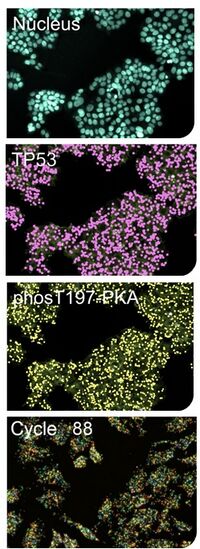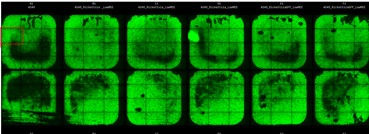BioMicroCenter:Element Sequencing
Element Sequencing
The Center currently hosts an AVITI24 platform from Element Biosciences. AVITI24 platform supports both sequencing and cytoprofiling. For most sequencing needs, the Center will use Element's Freestyle chemistry kits.
| Service | Element Sequencing |
|---|---|
| SUBMISSION | Illumina OR Element libraries |
| MIN VOLUME | 15 uL |
| MIN CONCENTRATION | 2 nM |
| INCLUDED SERVICES |
|
| ADDITIONAL SERVICES |
|
| DATA FORMATS |
|
| QUALITY CONTROL |
|
| PRICING | LINK |
| SUBMISSION |
|
Illumina library is preferred. Element libraries require a 5'-phosphate on the forward end in order to circularize and sequence. Compared to an Illumina platform, AVITI24 reads are similar in read direction to Illumina's Forward Strand workflow for Dual Indexed Libraries.
Minimum reads per lane are guaranteed if:
- the BMC has performed quality control,
- the samples have high diversity, especially within the first 5 bases of read 1, and
- submitted libraries are at least 2 nM.
Lane-by-lane Notes
- The wait is variable
- Custom primers must be compatible with TruSeq, Nextera, TruSeq, smRNA and Element sequencing primers
All other requests require a full flowcell. 300PE kits only have a single lane.
- Min custom primer submission: 70 uL at 100 uM for Read 1, all other reads require 40 uL at 100 uM.
The AVITI24 Platform
Aviti24 circularizes linear Element or Illumina libraries onboard, and then performs rolling circle amplification to generate thousands of copies of the original template on a single strand. The strand is then packaged up into a polony. These polonies are washed with a complex of primers, polymerase, and dye-labelled avidites. Avidites are multivalent-nucleotide-ligands on dye labeled cores capable of binding to multiple sites to form a polymerase–polymer–nucleotide complex within a polony. After an imaging step, the avidites are washed away and the growing read strand incorporates a single nucleotide that is reversibly blocked on the 3' end. The polonies are again loaded with avidites, repeating the process over many cycles.
The AVITI24 can run 2 flow cells per run, each hosting 2 independently-addressable lanes. Both lanes are washed with the same reagents. Element currently offers kits with 150 and 300 cycles, both supporting 2 lanes, as well as a 600 cycle kit that supports a single lane. Index hopping rates are virtually nil, limiting the need for UDI's. The AVITI24 can also perform direct in sample sequencing which includes spatial imaging of RNA, proteins, phospho-proteins, and cell morphology using Teton chemistry for cytoprofiling.
Cytoprofiling with AVITI24

A user can optimize the assay before attempting a Teton Run. This test will require an optimization kit. Optimization is similar to creating a slide for a Teton run. The standard steps of coating (or not) that slide, loading and culturing cells prior to fixing are all similar. Instead of running the optimization slide on the AVITI24, the optimization slide should be inspected with a fluorescence objective. This process requires a separate kit from the actual slide kits.
Users can pick up a 1- or 12-well Teton Slide kit from the Center. Currently, Poly-L-Lysine-coated and uncoated slide kits are available. Uncoated slides must be coated as laid out in the protocol and users should ensure that cell fixation is ideal for one of the possible coatings which are not PLL (currently: Collagen, Fibronectin, Gelatin, Laminin, Matrigel). Cells are loaded and cultured for the desired amount of time on coated slides. Cells are fixed and the Teton Slide may be stored at 2-8C for up to 30 days or may be run immediately on the AVITI24.
For a Teton Run, cells are washed in the appropriate Cell Paint reagents for a fixed panel or custom panel cytoprofiling assay. A single Teton slide can be used to infer Morphology, RNA within the cells, Protein and also direct in situ sequencing up to 100nt which is not robust enough for transcriptomics, but is sufficient for investigating CRISPR or TCR or other short sequences of interest.


